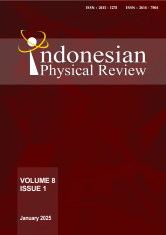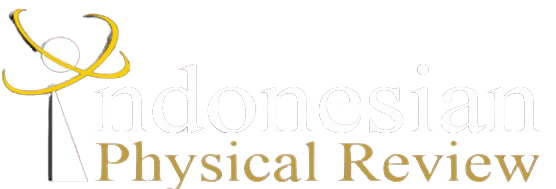SIMULATION OF PLACEMENT FOR FOAM INLET INJECTOR POSITION ON FIREFIGHTER JET NOZZLE
DOI:
10.29303/ipr.v8i1.398Downloads
Abstract
Water is a widely used and effective fire-extinguishing medium, but its effectiveness diminishes at high temperatures. By disrupting the oxygen chain in the fire triangle, Foam media can enhance suppression performance. This study simulates the impact of foam injector placement on the effectiveness of jet nozzles in fire extinguishers. Simulations were conducted with foam injectors positioned at the nozzle's inlet, middle, and outlet. Results indicate that placing the foam injector at the outlet provides optimal spray velocity, pressure, and extinguishing performance. These findings highlight the importance of injector placement in improving fire suppression efficiency for liquid-based extinguishing systems.
Keywords:
Fire Extinguisher Jet Nozzle Injector FoamReferences
N. Ghassempour, W. K. Tannous, K. E. Agho, G. Avsar, and L. A. Harvey, “Comparison of causes, characteristics and consequences of residential fires in social and non-social housing dwellings in New South Wales, Australia,†Prev Med Rep, vol. 28, Aug. 2022, doi: 10.1016/j.pmedr.2022.101860.
H. H. Sutrisno, “The Development of a Centrifugal Pump Nozzle for Firefighting Motorcycle,†International Journal of Mechanical Engineering and Robotics Research, vol. 10, no. 6, pp. 321–327, Jun. 2021, doi: 10.18178/ijmerr.10.6.321-327.
H. Hadi Sutrisno and Triyono, “Designing a Firefighter Motorcycle as an Effort to Provide an Early Response to Fire Disaster,†Journal of Mechanical Engineering, vol. 4, no. 1, pp. 249–261, 2017.
H. H. Sutrisno, “The selection of flying roller as an effort to increase the power of scooter-matic as the main power of centrifugal pump for firefighter motorcycle,†2018.
D. R. Katz et al., “Transport and fate of aqueous film forming foam in an urban estuary,†Environmental Pollution, vol. 300, p. 118963, 2022, doi: https://doi.org/10.1016/j.envpol.2022.118963.
H. H. Sutrisno, Wibawa, B., Triyono, T., Amiruddin, J., Kusumohadi, C. S., Setyadi, P., & Yoga, N. G. (2021). The identification of fire potentials in oil mining area on Minas Sumatera Operations-Indonesia by manual assessment method. IOP Conference Series: Materials Science and Engineering, 1098(6), 062093. doi: 10.1088/1757-899x/1098/6/062093
H. H. Sutrisno, Wirawan, R., Febriani, A., & Ambarwati, D. (2019). Analysis of fire rate on paper coated with the silica gel from rice husk ash. Journal of Physics: Conference Series, 1402(4), 044052. doi: 10.1088/1742-6596/1402/4/044052
Sutrisno, Himawan Hadi, Triyono, & Sari, Yunita. (2023a). Enhanced Thermal Resistance Of CFRP In Robotic Body Covering. International Journal of Mechanical Engineering and Robotics Research.
Sutrisno, Himawan Hadi, Triyono, & Sari, Yunita. (2023b). Experimental study of fire spreading CFRP based on the addition 1 of rice husk ash silica for Automotive Component. MEV Journal.
X. Fu et al., “Application of compressed air foam system in extinguishing oil tank fire and middle layer effect,†in Procedia Engineering, Elsevier Ltd, 2012, pp. 669–673. doi: 10.1016/j.proeng.2012.08.220.
H. Xie, “Heavy compressed air foam truck applied to high-rise building fires,†in Procedia Engineering, Elsevier Ltd, 2013, pp. 458–467. doi: 10.1016/j.proeng.2013.02.169.
H. Bin Wang and H. Xie, “Research on application of heavy compressed air foam truck applied in high-rise building fires,†in Procedia Engineering, Elsevier Ltd, 2014, pp. 276–285. doi: 10.1016/j.proeng.2014.04.040.
M. S. Shuvo, M. N. Sakib, R. Rahman, and S. Saha, “Particle deposition and characteristics of turbulent flow in converging and diverging nozzles using Eulerian-Lagrangian approach,†Results in Engineering, vol. 16, Dec. 2022, doi: 10.1016/j.rineng.2022.100669.
A. Ostadfar, “Chapter 1 - Fluid Mechanics and Biofluids Principles,†in Biofluid Mechanics, A. Ostadfar, Ed., Academic Press, 2016, pp. 1–60. doi: https://doi.org/10.1016/B978-0-12-802408-9.00001-6.
Y. Demirel, “5.2 Energy Conservation,†in Comprehensive Energy Systems, I. Dincer, Ed., Oxford: Elsevier, 2018, pp. 45–90. doi: https://doi.org/10.1016/B978-0-12-809597-3.00505-8.
B. Azarhoushang, “18 - Fluid delivery,†in Tribology and Fundamentals of Abrasive Machining Processes (Third Edition), Third Edition., B. Azarhoushang, I. D. Marinescu, W. Brian Rowe, B. Dimitrov, and H. Ohmori, Eds., William Andrew Publishing, 2022, pp. 653–687. doi: https://doi.org/10.1016/B978-0-12-823777-9.00004-5.
B. Kou, P. Huo, and X. Hou, “Research on the Influence of External Parameters of Fan-Type Nozzle on Water Jet Performance,†Shock and Vibration, vol. 2020, pp. 1–16, Nov. 2020, doi: 10.1155/2020/4386259.
J. Bahreh Bar, M. Gholami Parashkoohi, D. Mohammad Zamani, and H. Ghafori, “Simulation of parameters effects on fluid flow behavior in the spraying nozzle: A case study of greenhouse cultivation,†Results in Engineering, vol. 19, Sep. 2023, doi: 10.1016/j.rineng.2023.101223.
T. Huang, S. Diao, Z. Yang, Z. Huang, Y. Zhang, and H. Zhou, “Flow dynamics and heat transfer characteristics analysis for floatation nozzle using large eddy simulation and proper orthogonal decomposition method,†International Journal of Thermal Sciences, vol. 155, Sep. 2020, doi: 10.1016/j.ijthermalsci.2020.106402.
S. Guo et al., “A large-eddy simulation study of the transcritical mixing process in coaxial jet flow under supercritical condition,†J Supercrit Fluids, vol. 203, p. 106080, 2023, doi: https://doi.org/10.1016/j.supflu.2023.106080.
H. Shrigondekar, A. Chowdhury, and S. V. Prabhu, “Characterization of a simplex water mist nozzle and its performance in extinguishing liquid pool fire,†Exp Therm Fluid Sci, vol. 93, pp. 441–455, May 2018, doi: 10.1016/j.expthermflusci.2018.01.015.
Y. Jiang, J. Liu, H. Li, L. Hua, and Y. Yong, “Droplet distribution characteristics of impact sprinklers with circular and noncircular nozzles: Effect of nozzle aspect ratios and equivalent diameters,†Biosyst Eng, vol. 212, pp. 200–214, 2021, doi: https://doi.org/10.1016/j.biosystemseng.2021.10.013.
T. W. Jiang, Z. W. Huang, J. Bin Li, and Y. S. Zhou, “Internal flow mechanism of cone-straight nozzle,†Pet Sci, vol. 18, no. 5, pp. 1507–1519, Oct. 2021, doi: 10.1016/j.petsci.2021.08.008.
K. Wongcharee, K. Kunnarak, V. Chuwattanakul, and S. Eiamsa-Ard, “Heat transfer rate of swirling impinging jets issuing from a twisted tetra-lobed nozzle,†Case Studies in Thermal Engineering, vol. 22, Dec. 2020, doi: 10.1016/j.csite.2020.100780.
J. Tu et al., “Effect of foam air mixing on flame intensification – comparative experimental study of foam and water sprays extinguishing transformer oil pool fire,†Fire Saf J, vol. 133, p. 103664, 2022, doi: https://doi.org/10.1016/j.firesaf.2022.103664.
C. Jimenez-Junca, A. Sher, J.-C. Gumy, and K. Niranjan, “Production of milk foams by steam injection: The effects of steam pressure and nozzle design,†J Food Eng, vol. 166, pp. 247–254, 2015, doi: https://doi.org/10.1016/j.jfoodeng.2015.05.035.
Q. Wang, D. Wang, F. Han, F. Yang, and Y. Sheng, “Study and application on foam-water mist integrated dust control technology in fully mechanized excavation face,†Process Safety and Environmental Protection, vol. 133, pp. 41–50, Jan. 2020, doi: 10.1016/j.psep.2019.11.008.
Q. Huang, S. Wang, S. Wang, B. Tang, and J. Qiu, “A novel tool path planning method for machining triangular mesh surfaces based on geodesics in heat theory,†J Manuf Process, vol. 108, pp. 445–456, 2023, doi: https://doi.org/10.1016/j.jmapro.2023.11.019.
License

This work is licensed under a Creative Commons Attribution-NonCommercial-ShareAlike 4.0 International License.
Authors who publish with Indonesian Physical Review Journal, agree to the following terms:
- Authors retain copyright and grant the journal right of first publication with the work simultaneously licensed under a Creative Commons Attribution-ShareAlike 4.0 International Licence (CC BY SA-4.0). This license allows authors to use all articles, data sets, graphics, and appendices in data mining applications, search engines, web sites, blogs, and other platforms by providing an appropriate reference. The journal allows the author(s) to hold the copyright without restrictions and will retain publishing rights without restrictions.
- Authors are able to enter into separate, additional contractual arrangements for the non-exclusive distribution of the journal's published version of the work (e.g., post it to an institutional repository or publish it in a book), with an acknowledgment of its initial publication in Indonesian Physical Review Journal.
- Authors are permitted and encouraged to post their work online (e.g., in institutional repositories or on their website) prior to and during the submission process, as it can lead to productive exchanges, as well as earlier and greater citation of published work (See The Effect of Open Access).





